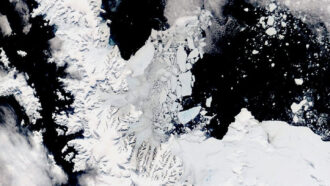Distant volcano could turn latest lunar eclipse dark red
Pollution spewed by Anak Krakatau’s eruption in Indonesia may darken an already red moon
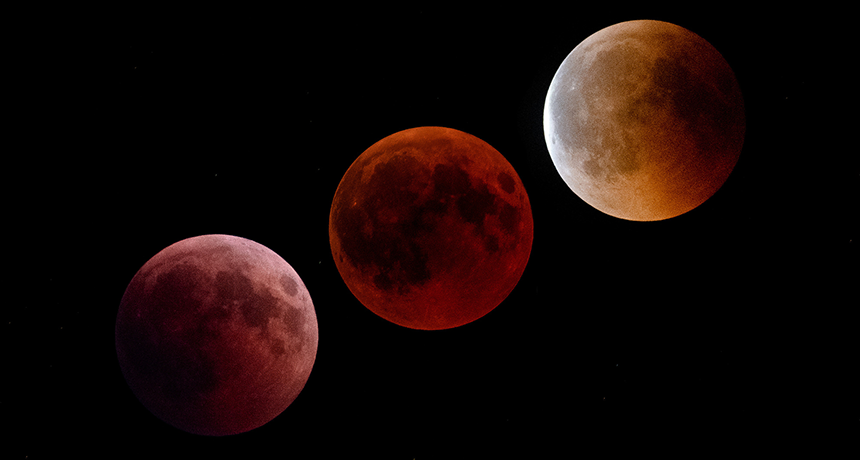
During a "total" lunar eclipse, the moon will remain partially visible in the sky but take on a dark red hue.
Bernd Thaller/Flickr (CC BY 2.0)
On the evening of January 20 to 21, the entire Western Hemisphere will be treated to a more-than-hour-long sky show: a total eclipse of the moon. And the eruption of a volcano half a world away could make this particular event especially colorful — as in deep red.
Total lunar eclipses aren’t rare. They happen somewhere across the globe once a year or so. But not everybody can see them. People have to be on the night side of Earth to catch the dark shadow fall over the moon’s face.
A lunar eclipse occurs when Earth moves between the sun and a full moon. At first, the moon appears to darken a bit as the shadow cast by Earth sweeps across the lunar surface. At what’s known as totality, Earth blocks out most moon-bound sunlight. This casts the darkest shadow. With only a fraction of the light passing through Earth’s razor-thin atmosphere, the moon plunges into sudden darkness.
But it doesn’t vanish entirely. That blanket of shadow, known as an umbra, lights up the moon enough that it remains slightly visible. It also turns the moon red. The reason has to do with optical physics. Most of the sunlight passing through our atmosphere will be scattered. Only the long-wavelength radiation — red light — penetrates. (It’s the same reason why sunsets appear red, orange and maroon.)
The moon rises Sunday (around 5:30 p.m. along the Atlantic coast, reaching its maximum eclipse near midnight for the Eastern Seaboard). Times will vary elsewhere, so be sure to check local information. Throughout North America, the moon will be high in the sky during the eclipse. That, plus a generally dry and clear night sky in winter, could make this the best viewing opportunity in years.
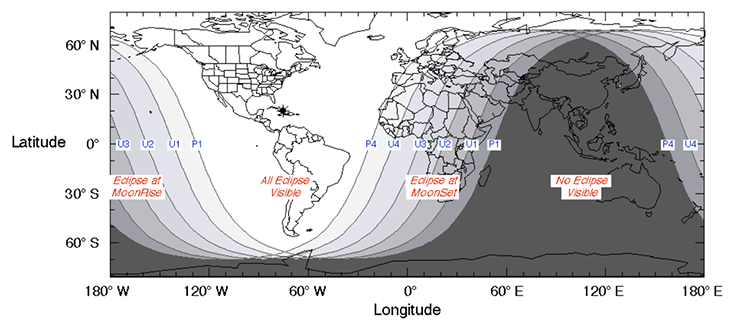
You might call this eclipse Big Red
This eclipse also will be supersized. That’s due to what some are calling a supermoon. That, too, is due to physics. The moon appears larger because it has been getting closer to Earth. At 357,342 kilometers (222,042 miles) away, it’s approaching its perigee — that point in its orbit when the moon will be nearest our planet. (If you’re looking for a super supermoon, you’ll have to wait until November 25, 2034. That’s when the moon will reach its closest in more than 85 years, according to TimeandDate.com.)
The January total lunar eclipse will be special for another reason: its color. One can never predict the specific red hue that will develop. But there is reason to suspect that this year’s will be deep. And that has to do with Anak Krakatau (AN-ak Kraa-kah-TAU). This volcano in Indonesia erupted with explosive force on December 22, 2018. The shock was so powerful that it sent a tsunami — a wall of water — racing ashore the beaches of the Sunda Strait. (This sudden, forceful flooding killed more than 400 people, according to the Red Cross.)
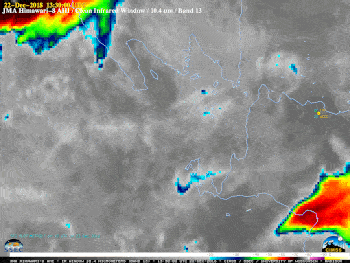
The volcano also lost 110,000,000 cubic meters in volume, dropping 229 meters (750 feet) in height. That’s according to Indonesia’s Centre for Volcanology and Geological Hazard Mitigation. All that ash and other debris had to go somewhere. Much of it shot high into the atmosphere. Along with it came copious smoke and airborne particles spewed by erupting lava itself.
This plume of ash and more towered to 16.1 kilometers (10 miles), according to an analysis of data collected by the Japanese weather satellite Himawari-8. Much of the aerosol and particulate matter was swept up by the jet stream. That’s a current of air that snakes around Earth some 10 kilometers (6 miles) above the surface. From Indonesia, it takes about two weeks for this high-altitude air pollution to make one round-the-world trek. So by mid-January, all the aerosols were fully mixed within the Southern Hemisphere’s upper atmosphere. (Mixing between the two hemispheres takes much longer.)
Since it’s summer there, the Southern Hemisphere is pointed toward the sun. That means sunlight passing through Earth’s atmosphere during totality will stream through more of the Southern Hemisphere’s, where all of that volcanic pollution is still hanging out. That should filter out even more sunlight than during a typical eclipse. If Sunday night’s moon looks darker, browner or more obscured than usual for an eclipse, you’ll know why.
Turning to history
This isn’t the first time a volcano has impacted eclipse viewing.
The late Richard B. Stothers worked at NASA’s Institute for Space Studies at the Goddard Space Flight Center in New York. He reviewed data on volcanic eruptions that had altered the color of eclipses. In 2005, he reported finding that recent volcanic activity seemed to darken a lunar eclipse. Indeed, he noted, “A dark eclipse on a clear night usually implies the presence of significant turbidity in the Earth’s stratosphere arising from a recent volcanic eruption.” By turbidity, he was referring to the ability of particles in the air to make it hard to see through to the sky above.
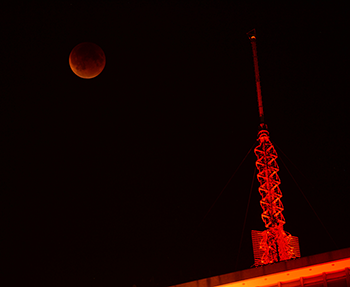
And activity at Krakatau (also known as Krakatoa) has dimmed lunar eclipses before. A great eruption there in 1883 pumped a huge amount of dust and gas into the upper atmosphere. Noted Stothers, this led “to a series of very dark lunar eclipses in the following 2 years.”
One of the darkest eclipses on record occurred on June 10, 1816. This was shortly after the eruption of Mount Tambora, another Indonesian volcano. Henrik B. Claussen was an astronomer at the University of Copenhagen in Denmark. His team studied Greenland ice cores using electrical conductivity. This let them gauge the amount of acid in different air pockets within the ice. They found an “acid signal” that came from sulfate pollution. Volcanoes often release lots of sulfates. And this sulfate was abundant in the ice that formed in 1816. That’s a year after Tambora’s 1815 eruption. And that makes sense: It would have taken volcanic pollutants that long to make it to the Northern Hemisphere and settle out in Greenland.
Sulfates are known to seed clouds. They can serve as a core around which supercooled water droplets collect. This can boost the number of small water droplets in the atmosphere. And those tiny droplets effectively scatter light, which can make the moon’s apparent change in color even more dramatic. It’s possible Anak Krakatau’s emissions could have that effect.
So when the moon goes red or brown on Sunday night, keep a watchful eye. It may be as informative about our planet as it is beautiful.






